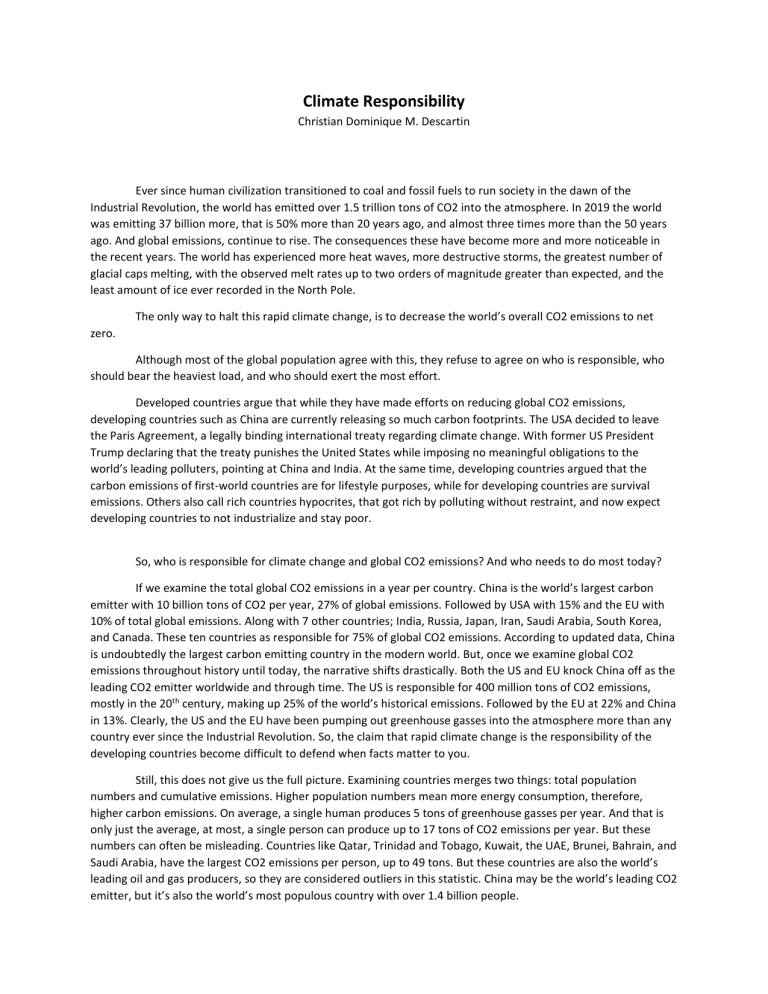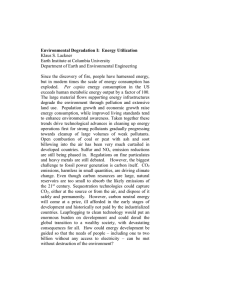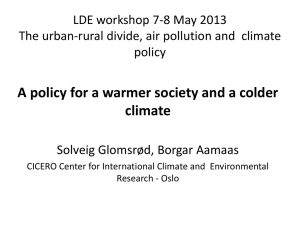
Climate Responsibility Christian Dominique M. Descartin Ever since human civilization transitioned to coal and fossil fuels to run society in the dawn of the Industrial Revolution, the world has emitted over 1.5 trillion tons of CO2 into the atmosphere. In 2019 the world was emitting 37 billion more, that is 50% more than 20 years ago, and almost three times more than the 50 years ago. And global emissions, continue to rise. The consequences these have become more and more noticeable in the recent years. The world has experienced more heat waves, more destructive storms, the greatest number of glacial caps melting, with the observed melt rates up to two orders of magnitude greater than expected, and the least amount of ice ever recorded in the North Pole. The only way to halt this rapid climate change, is to decrease the world’s overall CO2 emissions to net zero. Although most of the global population agree with this, they refuse to agree on who is responsible, who should bear the heaviest load, and who should exert the most effort. Developed countries argue that while they have made efforts on reducing global CO2 emissions, developing countries such as China are currently releasing so much carbon footprints. The USA decided to leave the Paris Agreement, a legally binding international treaty regarding climate change. With former US President Trump declaring that the treaty punishes the United States while imposing no meaningful obligations to the world’s leading polluters, pointing at China and India. At the same time, developing countries argued that the carbon emissions of first-world countries are for lifestyle purposes, while for developing countries are survival emissions. Others also call rich countries hypocrites, that got rich by polluting without restraint, and now expect developing countries to not industrialize and stay poor. So, who is responsible for climate change and global CO2 emissions? And who needs to do most today? If we examine the total global CO2 emissions in a year per country. China is the world’s largest carbon emitter with 10 billion tons of CO2 per year, 27% of global emissions. Followed by USA with 15% and the EU with 10% of total global emissions. Along with 7 other countries; India, Russia, Japan, Iran, Saudi Arabia, South Korea, and Canada. These ten countries as responsible for 75% of global CO2 emissions. According to updated data, China is undoubtedly the largest carbon emitting country in the modern world. But, once we examine global CO2 emissions throughout history until today, the narrative shifts drastically. Both the US and EU knock China off as the leading CO2 emitter worldwide and through time. The US is responsible for 400 million tons of CO2 emissions, mostly in the 20th century, making up 25% of the world’s historical emissions. Followed by the EU at 22% and China in 13%. Clearly, the US and the EU have been pumping out greenhouse gasses into the atmosphere more than any country ever since the Industrial Revolution. So, the claim that rapid climate change is the responsibility of the developing countries become difficult to defend when facts matter to you. Still, this does not give us the full picture. Examining countries merges two things: total population numbers and cumulative emissions. Higher population numbers mean more energy consumption, therefore, higher carbon emissions. On average, a single human produces 5 tons of greenhouse gasses per year. And that is only just the average, at most, a single person can produce up to 17 tons of CO2 emissions per year. But these numbers can often be misleading. Countries like Qatar, Trinidad and Tobago, Kuwait, the UAE, Brunei, Bahrain, and Saudi Arabia, have the largest CO2 emissions per person, up to 49 tons. But these countries are also the world’s leading oil and gas producers, so they are considered outliers in this statistic. China may be the world’s leading CO2 emitter, but it’s also the world’s most populous country with over 1.4 billion people. Wealth is also a strong indicator of our individual carbon footprints. The more wealth a person has, the more energy they consume. Excessive use of fuel for cars, travel, electricity, heating, modern cooking, smartphones, or computers, are mostly only available to those who can afford it. China’s rise to becoming the world’s leading CO2 emitter today, is coupled with the greatest reduction of poverty in history. If we examine global CO2 emissions by each country’s income, the richest half emit 86% of the global carbon emissions. The bottom half, only 14%. The average American emits 9 times more than an average Indian citizen. If the distribution were to be examined by each individual income, the richest of the global population would be responsible for an even greater percentage of global carbon emissions. Harsh reality is that the countries and individuals that contribute the least to the problem tend to suffer the most from rapid climate change. Developing countries will be affected the most. It could lead to food insecurity, problems over resources, harsher and more extreme natural disasters, and other numerous severe consequences. Back to the question we are trying to answer. Who should take responsibility for climate change? Many of today’s richest countries are in a very convenient position. They have become rich over decades of burning fossil fuels and industrial productions. They have a large historical carbon footprint, and with their massive wealth on hand, they still emit a lot per person. These countries have the resources, the education needed, and technology to produce low-cost, low-emission alternatives and spread them around the world. If we do not want developing countries to be as fossil fuel dependent as the rest of the world have been, we need lowcarbon technology to be cheap and readily available. We are getting there, the cost of renewable sources of energy have become relatively cheap these past few years and a wider variety of alternatives are on their way. But the transition needs to happen much faster. Another thing to consider is influence, China may be the largest carbon emitter right now, but if the richer countries decide to seriously tackle rapid climate change, the rest of the world will have to follow suit. Like when the EU enforced energy efficiency standards for technology, the rest of the world adapted to it to be able to continue trading with them. Although, this does not mean China and other developing countries are absolved of their accountability. It is also their responsibility to grow in a way where it will become possible to transition to a zero-carbon world in time. Others acting irresponsibly yesterday is a horrible excuse to continue doing the same mistakes today. Climate change is a global problem and no country, nor a single individual, can fix it all by themselves. Asking whether who is responsible and who should do the most is, in a way, a foolish question. But there is an answer, and the answer is simple. Everybody needs to do the best they can, and right now, not everyone is doing that. References JC. (n.d.). The Kaya Identity. Retrieved from https://www.actuaries.org.uk/system/files/field/document/Kaya%20identity_JC%20Final%2005 0219.pdf Kabat, P., Egerton, P., Baddour, O., Paterson, L., Nullis, C., Castonguay, S., & Walsh, M. (2019). United In Science. World Meteorological Organization. King, A. D., & Harrington, L. J. (2018). The Inequality of Climate Change From 1.5 to 2 degrees of Global Warming. Geophysical Research Letters. Retrieved from https://agupubs.onlinelibrary.wiley.com/doi/full/10.1029/2018GL078430 Maddison. (n.d.). Per Capita CO2 Emissions. Retrieved from Our World in Data: https://ourworldindata.org/grapher/co-emissions-percapita?tab=chart&country=AUS+CAN+USA+OWID_WRL+QAT+TTO+KWT+ARE+BRN+SAU+BHR+D EU Nations, U. (n.d.). The Paris Agreement. Retrieved from UNFCCC: https://unfccc.int/process-andmeetings/the-paris-agreement/the-paris-agreement Ritch, H., & Roser, M. (2020). CO₂ and Greenhouse Gas Emissions. Our World in Data. Retrieved from https://ourworldindata.org/co2-and-other-greenhouse-gas-emissions Ritchie , H., & Roser, M. (2020). CO2 and Greenhouse Gas Emissions. Our World in Data. Retrieved from https://ourworldindata.org/co2-and-other-greenhouse-gas-emission Ritchie, H. (2018). Global Inequalities in CO2 Emissions. Ouw World in Data. Retrieved from https://ourworldindata.org/co2-by-income-region#licence Sutherland, D., Jackson, R., Kienholz, C., Amundson , J., Dryer , W., Duncan , D., . . . Nash , J. (2019). Direct Obsevrations of Submarine Melt and Subsurface geometry at a tidewater glacier. Science, 369-374. Retrieved from https://doi.org/10.1126/science.aax3528 Weiping, D. T. (2018). China's Approach to Reduce Poverty: Taking Targeted Measures to Lift People out of Poverty. Retrieved from https://www.un.org/development/desa/dspd/wpcontent/uploads/sites/22/2018/05/31.pdf






